In today’s world of convenient processed foods and rising health concerns, understanding how different foods affect your body has never been more important. The glycemic index offers a valuable tool for making informed dietary choices that can impact your energy levels, weight management, and long-term health. This guide will help you understand what the glycemic index is, why it matters, and how you can use it to make better food choices every day.
What is the Glycemic Index?
The glycemic index measures how quickly foods raise blood sugar levels on a scale of 0-100
The glycemic index (GI) is a measurement system that ranks foods containing carbohydrates on a scale from 0 to 100 based on how quickly and how much they raise blood sugar levels after eating. Foods with a high GI are rapidly digested and cause significant fluctuations in blood sugar levels, while foods with a low GI are digested more slowly, producing a gradual rise in blood sugar.
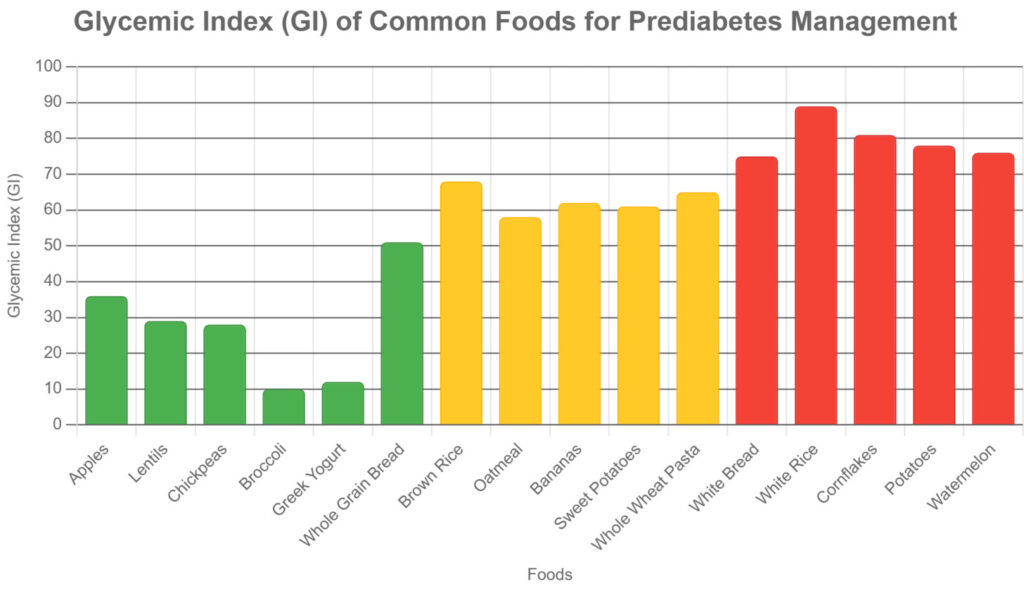
The GI scale is categorized as follows:
- Low GI (55 or less): Foods that cause a slow, minimal rise in blood sugar
- Medium GI (56-69): Foods that cause a moderate rise in blood sugar
- High GI (70 or above): Foods that cause a rapid, significant rise in blood sugar
It’s important to note that foods without carbohydrates, such as meats, fish, and oils, don’t have a GI value because they don’t significantly affect blood sugar levels on their own.
Want the Complete Food Guide?
Get our comprehensive Glycemic Index Food Guide with over 100 common foods and their GI values to help you make smarter dietary choices.
How the Glycemic Index Affects Your Blood Sugar
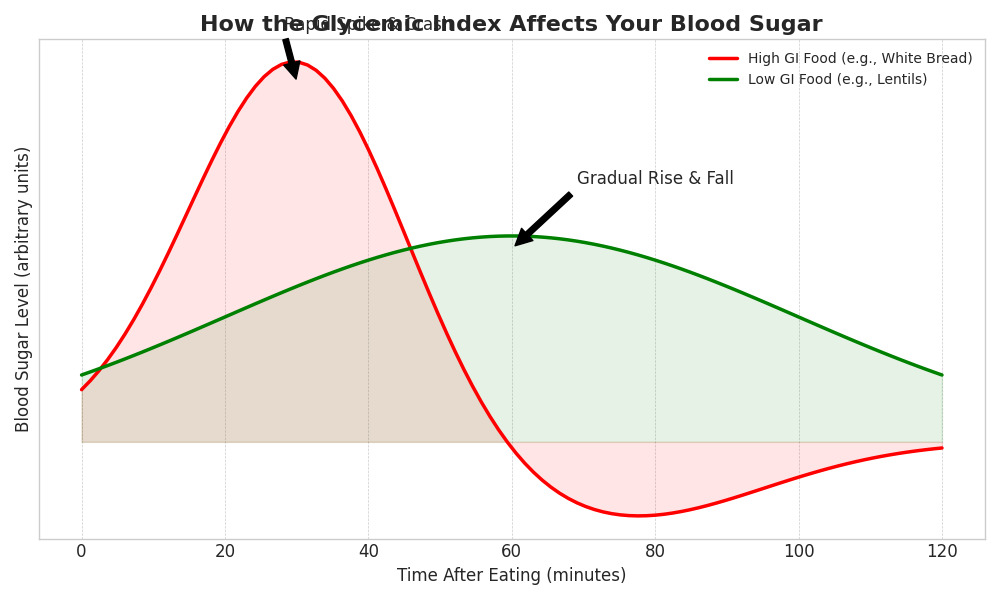
When you eat carbohydrates, your digestive system breaks them down into glucose, which enters your bloodstream. Your pancreas then releases insulin to help your cells absorb this glucose for energy or storage. The speed at which this process occurs varies depending on the type of carbohydrate consumed.
High GI Foods
Foods with a high glycemic index, like white bread and sugary drinks, are quickly broken down into glucose. This causes a rapid spike in blood sugar levels, followed by a surge of insulin. The quick rise and subsequent fall in blood sugar can lead to energy crashes, increased hunger, and over time, may contribute to insulin resistance.
Low GI Foods
Low glycemic index foods, such as legumes and most fruits, contain carbohydrates that break down more slowly. This results in a gradual increase in blood sugar levels, providing sustained energy and better satiety. The steady release of glucose helps maintain stable insulin levels, which is beneficial for long-term health.
Several factors affect a food’s glycemic index, including:
Food Processing
More processed foods generally have a higher GI. For example, fruit juice has a higher GI than whole fruit, and instant oatmeal has a higher GI than steel-cut oats.
Fiber Content
Foods high in soluble fiber tend to have a lower GI because fiber slows down the digestion and absorption of carbohydrates.
Cooking Methods
Cooking can affect a food’s GI. For instance, pasta cooked al dente has a lower GI than pasta cooked until very soft.
Glycemic Index of Common Foods
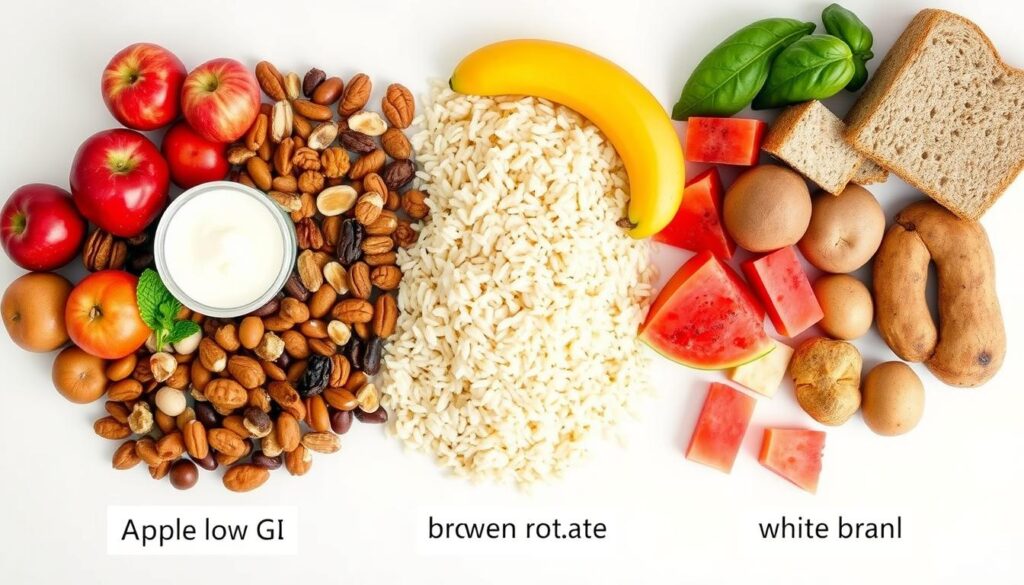
Understanding which foods fall into each glycemic index category can help you make more informed dietary choices. Here’s a comparison of common foods and their GI values:
| Low GI Foods (55 or less) | GI Value | High GI Foods (70 or above) | GI Value |
| Apples | 36 | White bread | 75 |
| Lentils | 32 | White rice | 73 |
| Greek yogurt | 11 | Instant oatmeal | 83 |
| Chickpeas | 28 | Russet potatoes | 78 |
| Barley | 28 | Cornflakes | 81 |
| Cherries | 22 | Watermelon | 72 |
| Quinoa | 53 | Sports drinks | 70 |
| Sweet potato | 44 | Pretzels | 83 |
| Whole grain pasta | 48 | Rice cakes | 82 |
| Oat bran | 55 | Bagels | 72 |
Important Note: The glycemic index of a food can be affected by ripeness (riper fruits have higher GI), cooking time (longer cooking increases GI), and food combinations (eating protein and fat with carbohydrates can lower the overall GI of a meal).
Health Benefits of Following a Low-GI Diet

Research has shown that following a low glycemic index diet can provide numerous health benefits. Here are some of the key advantages supported by scientific evidence:
Improved Diabetes Management
Multiple studies have demonstrated that low-GI diets can help improve blood sugar control in people with type 2 diabetes. A systematic review published in the journal Diabetes Care found that low-GI diets reduced HbA1c levels (a measure of long-term blood sugar control) by an average of 0.4% compared to high-GI diets.
Weight Management
Low-GI foods tend to promote satiety (feeling full) for longer periods, which may help with weight management. Research published in the American Journal of Clinical Nutrition found that participants following a low-GI diet experienced greater weight loss and were more likely to maintain that loss compared to those on a high-GI diet.
Heart Health
A low-GI diet may help reduce risk factors for cardiovascular disease. Studies have shown improvements in cholesterol levels, with increases in HDL (good) cholesterol and decreases in LDL (bad) cholesterol and triglycerides. Research in the British Journal of Nutrition linked low-GI diets to reduced inflammation markers associated with heart disease.
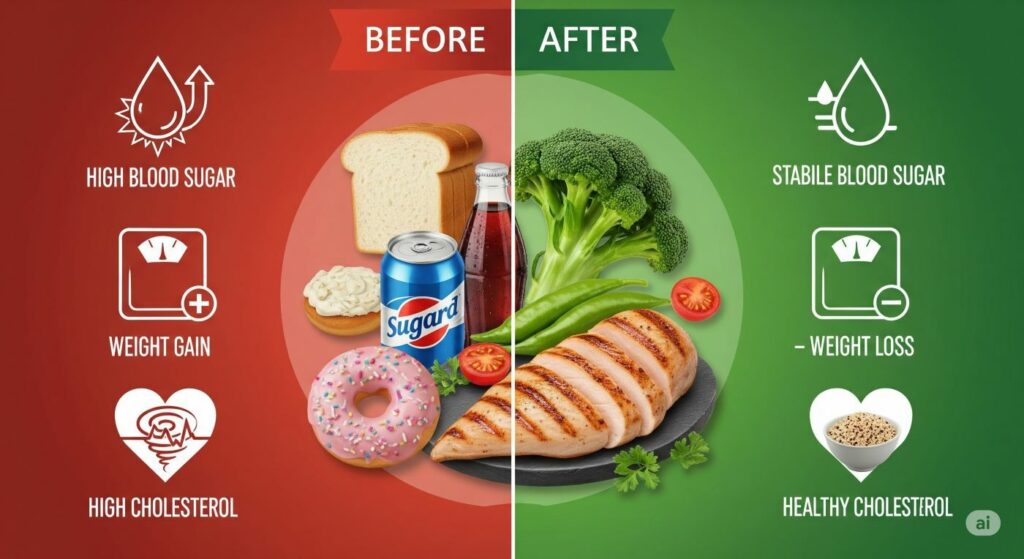
Additional benefits of following a low-GI diet include:
- Reduced risk of developing type 2 diabetes
- More stable energy levels throughout the day
- Improved cognitive function and concentration
- Potential reduction in acne and certain inflammatory conditions
- Better overall dietary quality due to focus on whole, unprocessed foods
Ready to Transform Your Diet?
Get a personalized low-GI meal plan tailored to your preferences and health goals. Our nutrition experts will help you balance your blood sugar while enjoying delicious meals.
Practical Tips for Adopting a Low-GI Diet

Transitioning to a low-GI diet doesn’t have to be complicated. Here are practical strategies to help you incorporate more low-GI foods into your daily meals:
Smart Swaps for Everyday Meals
| Instead of (High GI) | Choose (Low GI) | Benefits |
| White bread | Whole grain bread or sourdough | More fiber, slower digestion, better satiety |
| White rice | Basmati rice, quinoa, or barley | More nutrients, steadier energy release |
| Regular pasta | Al dente whole grain pasta | Higher fiber content, more stable blood sugar |
| Instant oatmeal | Steel-cut or rolled oats | Less processing, slower digestion |
| Fruit juice | Whole fruits | More fiber, fewer sugar spikes |
Meal Planning Strategies
- Steel-cut oatmeal with berries and nuts
- Greek yogurt with fresh fruit and a sprinkle of cinnamon
- Whole grain toast with avocado and eggs
- Overnight chia seed pudding with almond milk
- Vegetable omelet with a side of fresh fruit
Breakfast Ideas
- Lentil soup with a side salad
- Quinoa bowl with roasted vegetables and chickpeas
- Whole grain wrap with hummus and vegetables
- Mixed bean salad with olive oil dressing
- Leftover dinner proteins with fresh vegetables
Lunch Ideas
- Grilled fish with steamed vegetables and barley
- Chicken stir-fry with plenty of vegetables and brown rice
- Bean and vegetable chili with a small portion of brown rice
- Zucchini noodles with tomato sauce and lean protein
- Stuffed bell peppers with quinoa and ground turkey
Dinner Ideas
Additional Tips for Success
- Balance your plate: Aim for ¼ protein, ¼ low-GI carbs, and ½ non-starchy vegetables
- Combine foods strategically: Eating protein, healthy fats, or fiber alongside carbohydrates can lower the overall glycemic impact of a meal
- Be mindful of portion sizes: Even low-GI foods can affect blood sugar if consumed in large quantities
- Stay hydrated: Drinking water before meals can help with portion control and digestion
- Read food labels: Look for higher fiber content and lower added sugars
- Cook at home more often: This gives you control over ingredients and cooking methods
- Experiment with herbs and spices: They add flavor without affecting blood sugar
- Plan ahead: Meal prep can help you avoid reaching for convenient high-GI options when hungry
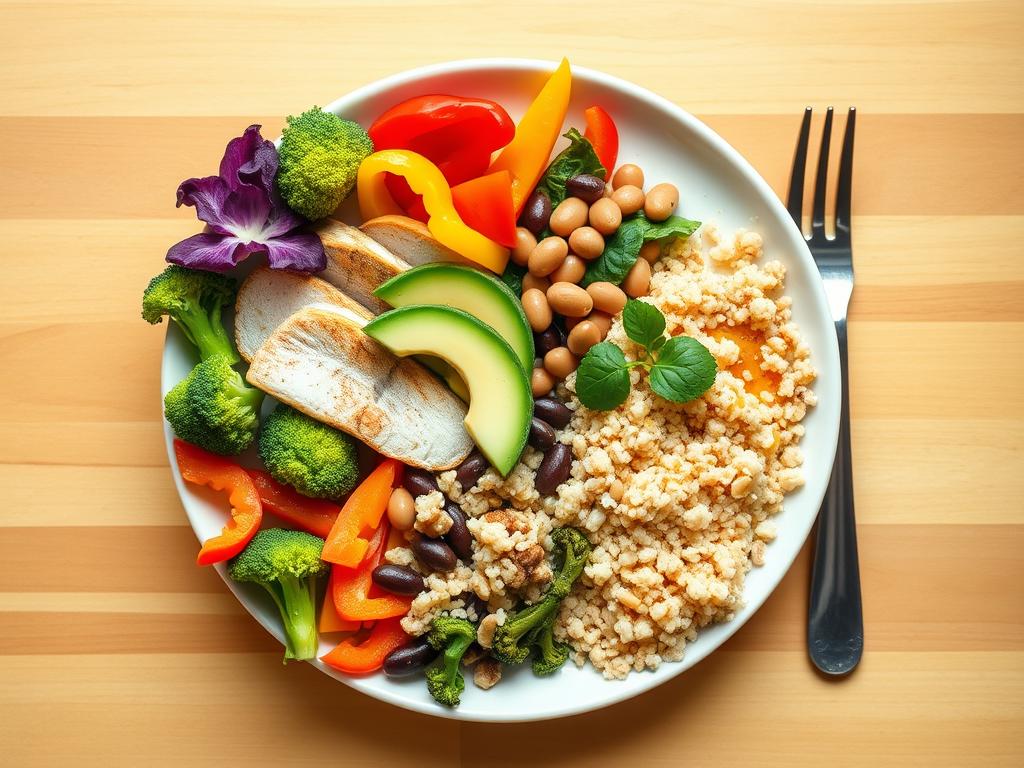
Conclusion: Making the Glycemic Index Work for You
Understanding and applying the glycemic index concept to your diet doesn’t mean eliminating all high-GI foods or obsessively tracking every meal. Instead, it’s about making informed choices that help maintain stable blood sugar levels and support your overall health goals.
Remember that the glycemic index is just one tool for evaluating food quality. Other factors like nutrient density, portion sizes, and your overall dietary pattern are equally important. By gradually incorporating more low-GI foods into your meals and being mindful of high-GI options, you can create a sustainable eating pattern that supports balanced blood sugar levels and long-term health.
Start with small changes, like swapping white bread for whole grain or choosing fruit instead of fruit juice. Over time, these adjustments can lead to significant improvements in your energy levels, weight management, and overall well-being.
Join Our Community
Connect with others on their low-GI journey. Get recipes, tips, and support from our community of health-conscious individuals and nutrition experts.
“The food you eat can be either the safest and most powerful form of medicine or the slowest form of poison.” – Ann Wigmore

